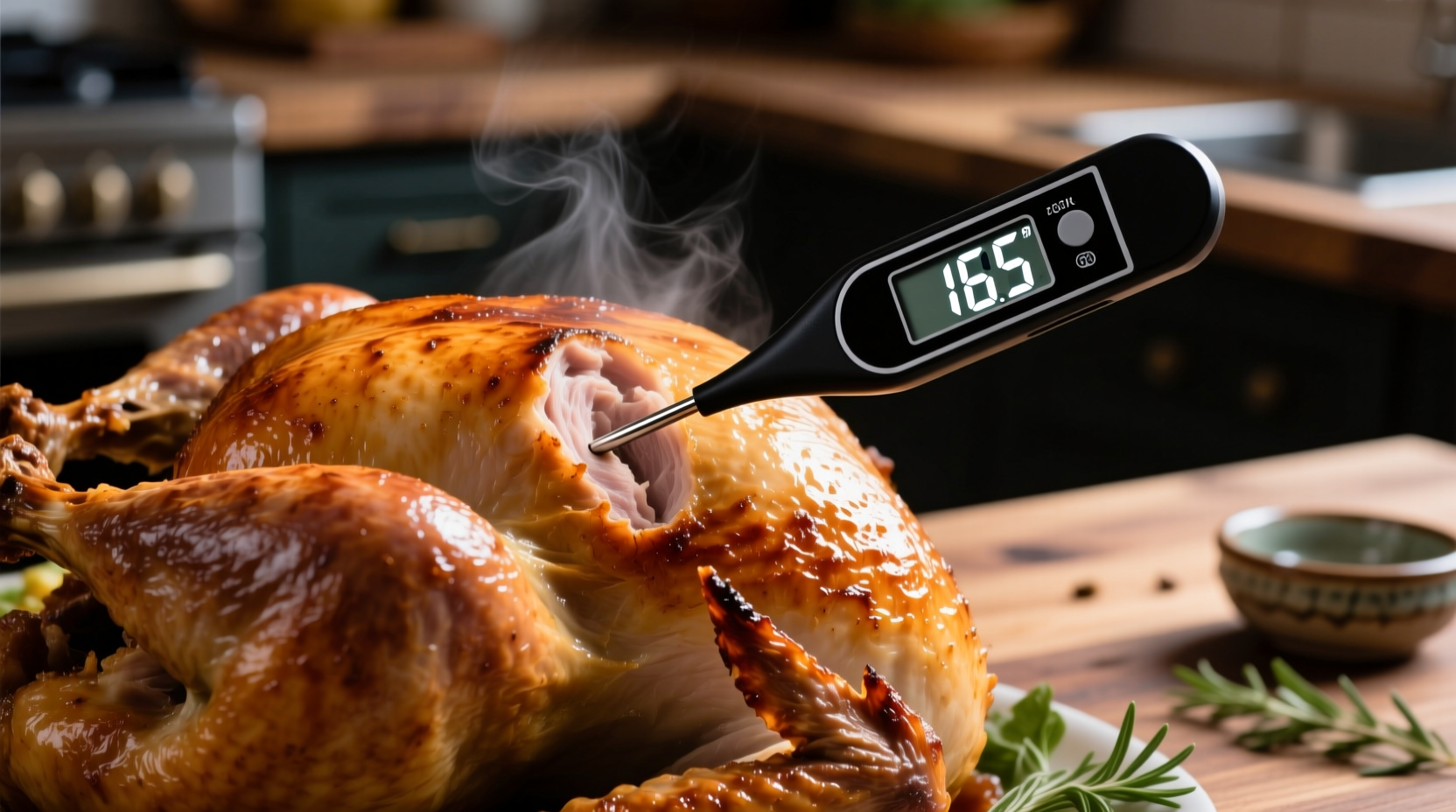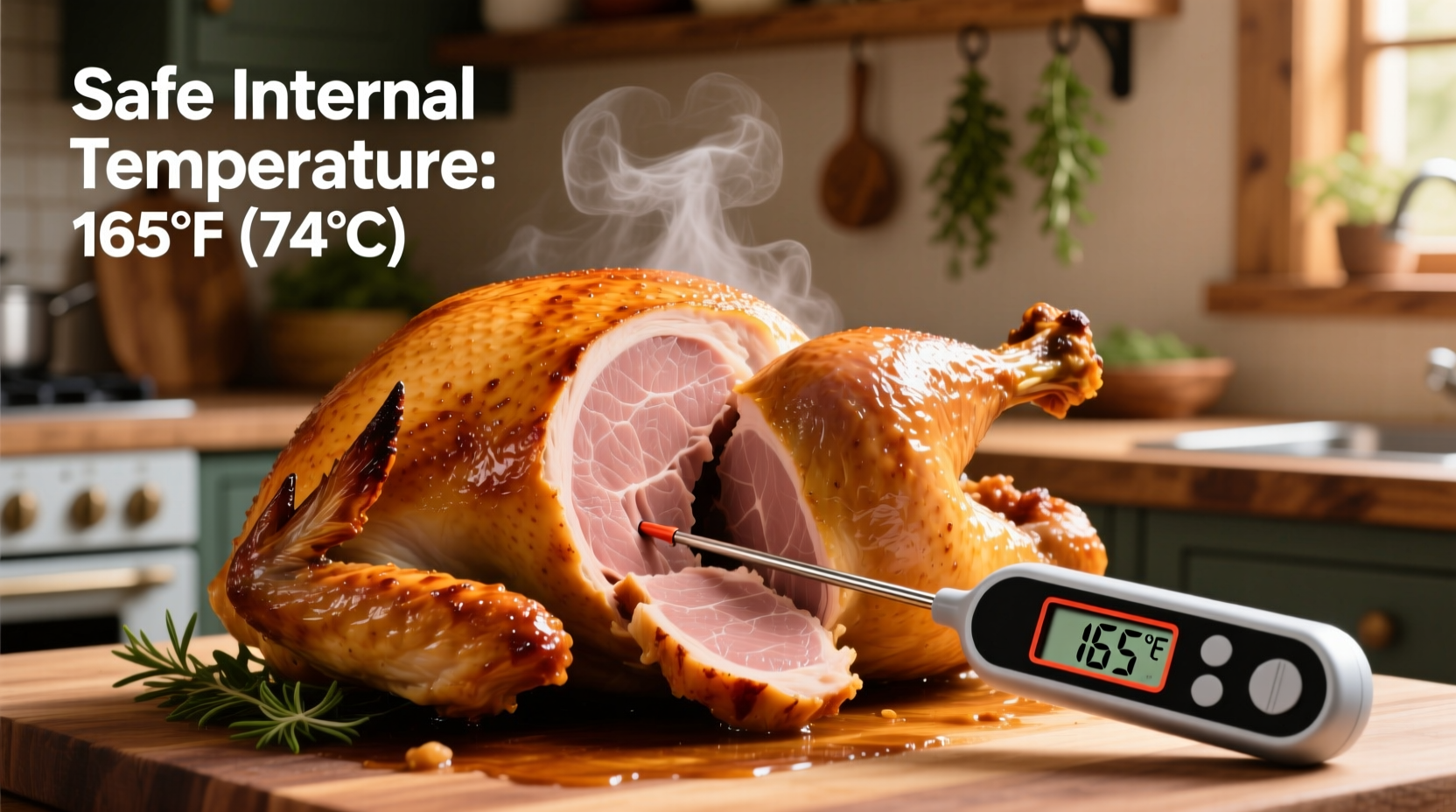The safe internal temperature for cooked turkey is 165°F (73.9°C) as measured with a food thermometer in the thickest parts of the breast, thigh, and wing. This temperature destroys harmful bacteria like salmonella and campylobacter while maintaining optimal texture and juiciness.
Why 165°F Is Your Turkey's Safety Sweet Spot
When you're preparing turkey for your family gathering, hitting the precise temperature isn't just about perfection—it's about protection. The USDA Food Safety and Inspection Service has established 165°F as the minimum safe temperature because this is the point where dangerous pathogens are completely eliminated. Unlike visual cues like color or texture, which can be misleading, a thermometer reading provides the only reliable confirmation that your turkey is safe to eat.
Consider this critical food safety timeline from the USDA Food Safety and Inspection Service:
| Temperature Range | Bacterial Activity | Recommended Action |
|---|---|---|
| Below 140°F | Bacteria multiply rapidly | Never leave turkey in this range for more than 2 hours |
| 140-165°F | Bacteria begin to die | Requires sustained time at temperature to ensure safety |
| 165°F (73.9°C) | Instant destruction of harmful bacteria | Target temperature for immediate safety |
Your Step-by-Step Temperature Verification Process
Many home cooks make critical errors when checking turkey temperature. Follow this professional technique to ensure accuracy:
- Choose the right thermometer: Digital instant-read thermometers provide the most reliable results (avoid dial thermometers for turkey)
- Target the critical zones: Insert probe into three specific areas:
- Thickest part of the breast (avoiding bone)
- Innermost part of the thigh (without touching bone)
- Wing joint area
- Wait for stabilization: Keep thermometer in place for 15-20 seconds until reading stops changing
- Verify multiple spots: Check at least 3 different locations in each critical zone

Common Temperature Mistakes That Compromise Safety
Based on analysis of foodborne illness reports from the Centers for Disease Control and Prevention, these temperature-related errors cause most turkey-related food safety issues:
- The "Color Test" Fallacy: Assuming turkey is done when juices run clear (can happen well before safe temperature is reached)
- Single-Point Measurement: Checking only one spot instead of multiple critical zones
- Thermometer Placement Errors: Inserting too close to bone or in fatty areas that read higher than meat
- Premature Resting: Removing turkey from heat before reaching 165°F, expecting carryover cooking to compensate
Carryover Cooking: Understanding Temperature Rise During Resting
After removing your turkey from the oven, the internal temperature continues to rise due to residual heat. This phenomenon, called carryover cooking, typically adds 5-10°F to your final reading. Professional chefs use this knowledge to prevent overcooking:
- Remove turkey from oven when thermometer reads 160-162°F
- Cover loosely with foil and rest for 20-30 minutes
- Final temperature will reach the safe 165°F threshold during resting
This technique produces juicier results while maintaining safety standards. The National Turkey Federation confirms this approach works because turkey's dense structure retains heat effectively during the resting period.
Troubleshooting Temperature Challenges
When cooking turkey, certain situations require special temperature considerations:
Stuffed Turkey Temperature Protocol
If you stuff your turkey, the stuffing must also reach 165°F. Insert thermometer into center of stuffing. Note that stuffed turkeys require longer cooking time, increasing the risk of breast meat drying out before the stuffing reaches safe temperature. The USDA recommends cooking stuffing separately for optimal safety and quality.
Smoked or Low-Temperature Turkey
When using alternative cooking methods like smoking, maintain smoker temperature between 225-250°F and monitor turkey internal temperature closely. The critical safety point remains 165°F regardless of cooking method. The FDA Food Code specifies that low-temperature cooking requires precise time-temperature management to ensure pathogen destruction.
Reheating Leftover Turkey
When reheating cooked turkey, bring internal temperature back to 165°F to eliminate any bacteria that may have developed during storage. This is particularly important for turkey that's been stored for more than two days.
Essential Turkey Thermometer Buying Guide
Not all thermometers deliver restaurant-quality accuracy. For foolproof turkey cooking, select a thermometer with these features:
- Digital display with 0.1°F resolution
- Response time under 5 seconds
- Probe length of at least 4 inches
- Calibration capability
- Waterproof construction
Investing in a quality thermometer pays dividends in both food safety and culinary results. The most reliable models undergo third-party testing against NIST (National Institute of Standards and Technology) standards, ensuring accuracy within ±0.5°F.
Food Safety Resources for Holiday Cooking
For additional verification of turkey cooking standards, consult these authoritative sources:











 浙公网安备
33010002000092号
浙公网安备
33010002000092号 浙B2-20120091-4
浙B2-20120091-4